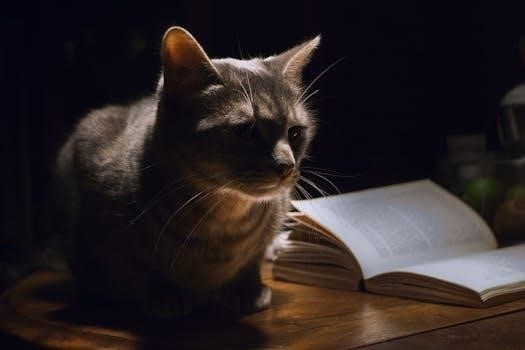
Overview of “Good Night Gorilla”
Good Night Gorilla, by Peggy Rathmann, is a beloved children’s book that tells a silent story primarily through illustrations․ It follows a zookeeper’s nightly routine as a mischievous gorilla secretly unlocks the cages․
The Story’s Premise
The core premise of Good Night Gorilla revolves around a zookeeper making his rounds to say goodnight to the animals․ Unbeknownst to him, a sneaky gorilla follows him, unlocking each cage with a set of keys he cleverly snatches․ As the zookeeper continues his routine, the animals quietly trail behind him, creating a humorous, visual narrative․ The story unfolds almost entirely through pictures, emphasizing the gorilla’s playful antics and the zookeeper’s oblivious nature․ This silent storytelling approach allows young readers to actively engage with the illustrations, piecing together the events and discovering the unfolding surprise․ The book’s charm lies in its simplicity and the engaging sequence of events that lead to a cozy conclusion․
Availability of “Good Night Gorilla” in PDF Format
The book, Good Night Gorilla, is widely available in PDF format online․ Many sources offer free downloads or flip PDF versions for convenient digital access․
Free PDF Downloads
Numerous online platforms offer Good Night Gorilla as a free PDF download, making it easily accessible for parents, educators, and children․ These free versions often come from digital libraries, educational resource sites, or personal archives shared online․ Users looking for a free digital copy of the book can often find it through a simple search, with multiple sites hosting the PDF․ These downloads provide a convenient way to enjoy the story on various devices, without the need for a physical book․ While some sites might require a simple registration, many offer direct downloads with no strings attached․ It’s always a good idea to ensure the source is reliable before downloading․ The availability of free PDFs allows the book to reach a broader audience, fostering a love of reading in more children․
Flip PDF Versions
Interactive flip PDF versions of Good Night Gorilla are also available online, offering a dynamic reading experience․ These versions simulate the act of flipping through the pages of a physical book, often with added features like zoom capabilities and thumbnail views․ Several educational institutions and digital libraries have created flip PDF versions, enhancing the accessibility and engagement of the story․ These formats are particularly beneficial for online storytelling sessions or for use on tablets and computers․ The flip PDF versions retain the original illustrations and text, allowing readers to enjoy the book in a user-friendly, digital format․ Many sites provide direct access to these versions without requiring any software downloads․ These interactive versions are a good alternative to traditional PDFs․

Key Elements of the Book
The book features a cast of zoo animals, a zookeeper, and a sneaky gorilla who leads a nighttime adventure․ The illustrations are key to the story’s charm, showing the gorilla’s antics․
Characters⁚ Animals and Zookeeper
The central characters in Good Night Gorilla include a kind but rather oblivious zookeeper, who goes about his nightly rounds, bidding good night to each animal․ Unbeknownst to him, a clever gorilla is the main catalyst for the story’s playful plot․ Other notable animals featured in the book include a friendly elephant, a majestic lion, a goofy hyena, and a tall giraffe, each with their unique characteristics․ There is also an armadillo included, creating a diverse cast․ These animals, through their actions and expressions, bring the story to life and capture the reader’s imagination․ Each animal is carefully illustrated, enhancing the narrative’s visual appeal and adding to its charm․ The interactions between the animals and the zookeeper, though silent, are integral to the story’s gentle humor and lightheartedness․
Plot Summary⁚ The Sneaky Gorilla
The narrative of Good Night Gorilla revolves around a zookeeper’s bedtime routine․ Each night, he makes his rounds, saying good night to each animal․ However, a sneaky gorilla has other plans․ As the zookeeper moves along, the gorilla quietly unlocks his cage and follows behind him, taking the zookeeper’s keys․ The gorilla then proceeds to unlock the other animals’ cages as they join the procession․ They all follow the zookeeper home, where he finally bids his wife good night and goes to bed․ The animals quietly settle into his bedroom before the zookeeper finally notices the surprise․ The book’s humor arises from the silent antics of the gorilla and the zookeeper’s obliviousness to the animal’s actions, which is unveiled through detailed illustrations․
Illustrations and Visual Storytelling
The power of Good Night Gorilla lies heavily in its illustrations․ Peggy Rathmann’s artwork is both detailed and expressive, conveying the story without the need for many words․ The illustrations play a vital role in the narrative․ The reader can see the mischievous glint in the gorilla’s eye, the quiet movements of the animals, and the zookeeper’s unawareness․ The use of color and light enhances the mood, moving from the dim zoo to the warmly lit zookeeper’s home․ Subtle details, such as the animals carrying their favorite items, add layers of humor and interest․ The visual storytelling is so effective that even the youngest readers can follow the plot through the pictures alone․ The illustrations allow for interactive storytelling, encouraging conversations and observations about the various characters and their silent adventures․

Educational Aspects and Target Audience
Good Night Gorilla is an excellent educational tool for young children․ It helps with learning animal names, sounds, and encourages visual literacy․ The interactive nature of the book promotes engagement․
Learning New Words and Sounds
Good Night Gorilla, while having minimal text, provides a rich opportunity for learning new words and sounds, particularly for young children․ The book introduces various animal names like gorilla, elephant, lion, hyena, and giraffe, which can expand a child’s vocabulary․ The sounds associated with these animals, such as the lion’s roar or the elephant’s trumpet, can also be explored through interactive reading․ The book also uses simple words like “good night”, “keys”, “lock” and “cage” that are easy for young children to learn․ The repetitive nature of the zookeeper saying good night to each animal helps reinforce these words․ Furthermore, the visual cues within the illustrations allow children to connect the words and sounds with the corresponding images, enhancing their learning experience․ The book subtly encourages early language development․
Interactive Storytelling
Good Night Gorilla is exceptionally suited for interactive storytelling due to its minimal text and engaging illustrations․ The story’s visual narrative encourages children to actively participate in the storytelling process, prompting questions like “What is the gorilla doing?” or “Where are the animals going?”․ Parents and educators can use the book as a springboard for discussions, asking children to predict what will happen next or to describe the animals’ actions․ The book also lends itself well to mimicking animal sounds, making story time more dynamic and fun․ The interactive nature of reading Good Night Gorilla transforms the experience from passive listening to active engagement, fostering a deeper connection with the story and encouraging creativity in young readers; The absence of extensive text allows for multiple interpretations of the events, making each storytelling session unique․
Suitability for Young Children
Good Night Gorilla is exceptionally well-suited for young children due to its simple narrative and captivating illustrations․ The book’s limited text makes it easily accessible for toddlers and preschoolers, while the detailed pictures provide ample opportunity for visual exploration and engagement․ The repetition of the “good night” phrase is comforting and aids in language development, while the playful antics of the gorilla and other animals keep young readers entertained․ The book’s predictable structure and clear visual cues make it easy for even the youngest children to follow along and feel a sense of accomplishment in understanding the story․ The bright colors and expressive characters also appeal to young children’s visual sensibilities, making it a delightful and engaging choice for bedtime reading or early literacy activities․ The gentle humor and heartwarming ending also make it a perfect book for repeated readings․

Publication Details and Formats
Good Night Gorilla was published by G․P․ Putnam’s Sons in 1996․ It is available in various formats, including board book and standard editions, and is easily found as a PDF online․
Publisher and Publication Date
Good Night Gorilla was initially brought to the world by G․P․ Putnam’s Sons, a well-known publisher of children’s literature․ The original publication date for this charming book was in 1996, marking the beginning of its journey into the hearts of young readers and families․ This publication date is significant as it places the book within a specific era of children’s literature, showcasing the style and art of the time․ Since its debut, the book has remained a popular choice, proving its timeless appeal through its simple yet engaging narrative and delightful illustrations․ The enduring popularity of the book has led to its continued availability in various formats and editions, ensuring that new generations can discover and enjoy this enchanting story․ The consistent reprinting and wide availability are testaments to the strong impact it has had on young audiences over the years․
Different Editions⁚ Board Book and Others
Good Night Gorilla has been released in various editions, catering to different age groups and preferences, with a notable offering being the board book version․ The board book edition is particularly popular for very young children, due to its durable pages that can withstand rough handling․ This format also enhances the reading experience for toddlers who are still developing their fine motor skills․ Besides the board book, Good Night Gorilla is also available in standard hardcover and paperback formats, providing options for older children and families who prefer traditional book styles․ Additionally, digital versions, such as PDF and flipbook formats, are available, making the story accessible on various devices․ These different editions and formats ensure that the book remains accessible to a wide range of readers, adapting to various reading environments and technology preferences․

Additional Resources
Beyond the book itself, online resources offer supplementary materials like activity sheets and workbooks․ These enhance the reading experience, providing educational extensions and activities related to the Good Night Gorilla story․
Online Libraries and Archives
Numerous online libraries and archives provide access to digital versions of Good Night Gorilla, often in PDF format․ These platforms serve as valuable resources for readers seeking to experience the book online․ Internet Archive, for instance, offers a scanned version of the book, allowing users to virtually flip through its pages․ Additionally, some digital libraries associated with educational institutions or public libraries may also host the book in their collections․ These online archives ensure that the charming story of the sneaky gorilla is widely available for families and educators alike․ It is worth checking these digital platforms regularly as availability may change due to various licensing agreements or copyright reasons․
Related Workbooks and Activities
Complementing the Good Night Gorilla book, various workbooks and activities are available to enhance the learning experience․ These resources often include exercises focusing on identifying animals, practicing new words, and improving observation skills․ Some workbooks provide coloring pages featuring characters from the book, while others offer interactive tasks that encourage children to retell the story․ Additional materials might incorporate matching games, tracing activities, and simple puzzles․ These related resources aim to expand on the themes and characters of the original book, making it a fun, educational tool for young readers․ Workbooks and activity sheets help to extend the enjoyment of the book and keep children engaged․